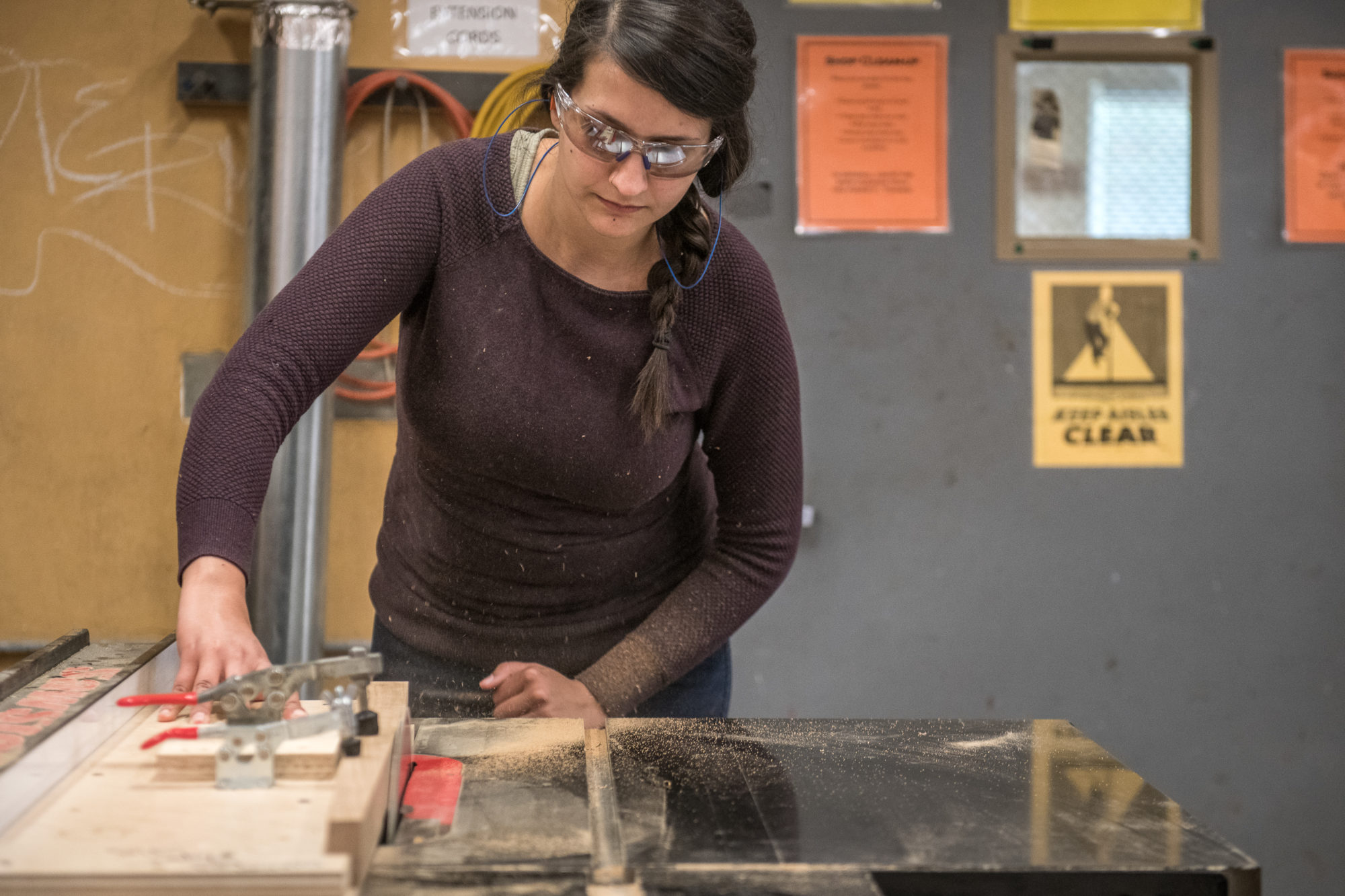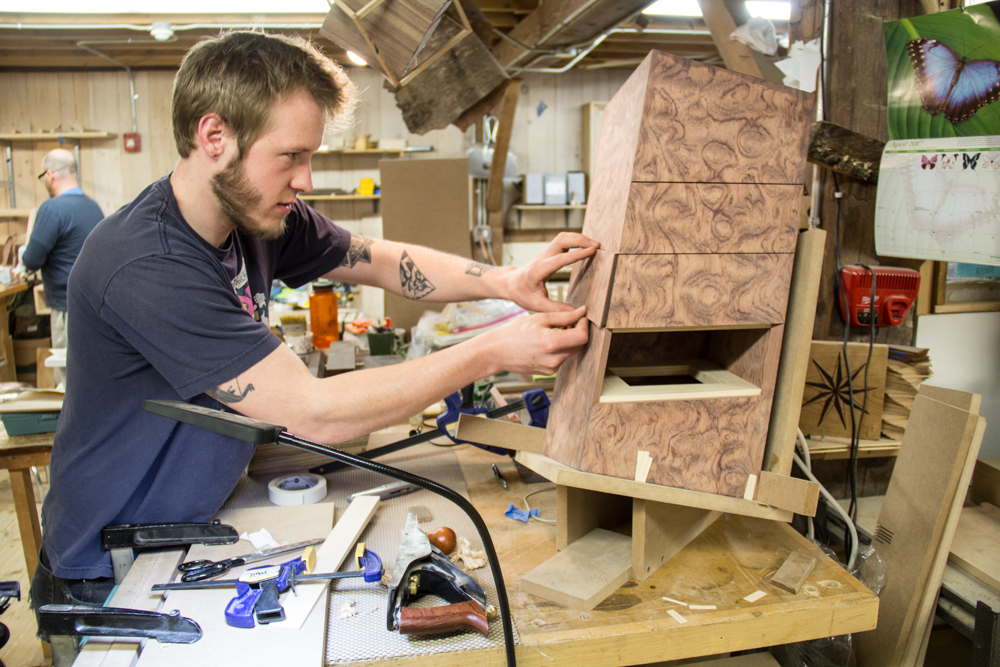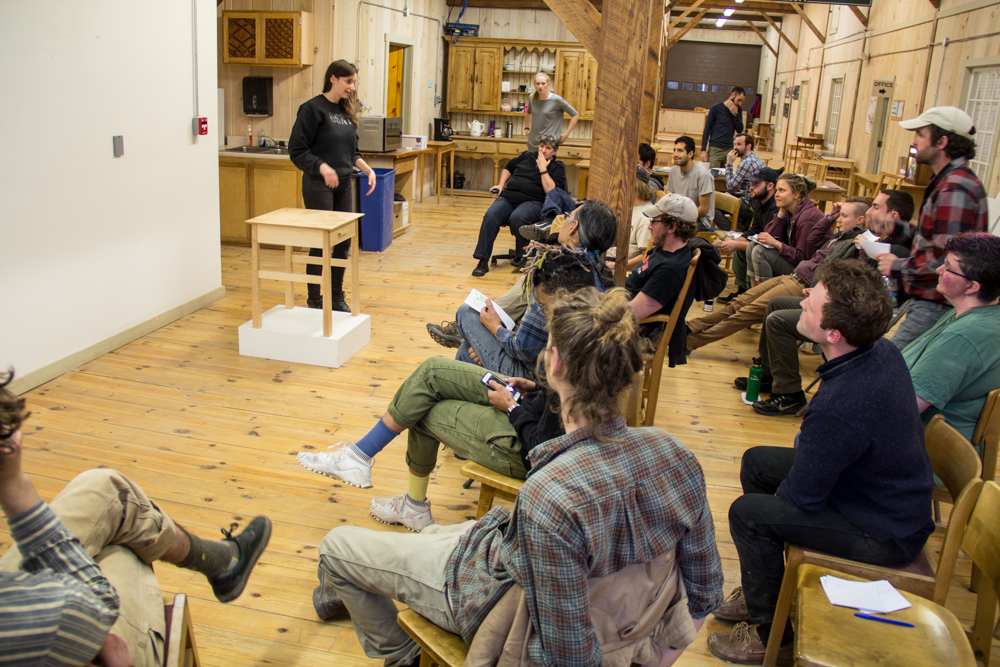Teaching the Trade: Vermont Schools Train the Next Generation of Loggers, Foresters, Builders, and Artists
August 30, 2018

By Christine McGowan, forest program director, Vermont Sustainable Jobs Fund
Like many trade occupations, woodworking was traditionally passed along from mentor to apprentice, one generation to the next. Young adults might have been introduced to the fundamentals of woodworking in high school shop class, producing the mandatory birdhouse or book shelf, but most who entered the vocation did so with on-the-job training or an apprenticeship. In recent years, however, trade schools have emerged offering robust, holistic curriculums around not only woodworking, logging and forestry, but also computer design, business skills, and marketing, offering students an alternative career path and supplying the industry with the next generation of skilled workers.
With the cost of college on the rise, trade schools and specialized programs are seeing a resurgence. The U.S. Department of Education reports that while there were roughly 9.66 million students attending trade schools in 1999, an estimated 16 million were enrolled in 2014. In addition to being more affordable and offering a skill set directly aligned with a career, skilled trade workers are also in demand. Here in Vermont, trade schools such as the Green Mountain Technology and Career Center, The Vermont Woodworking School, and Yestermorrow Design/Build School, have developed certificate, undergraduate, and professional development programs attracting students ranging from high schoolers to homesteaders.

Photo Courtesy of Vermont Woodworking School.
Vermont Woodworking School
Founded in 2007, the Vermont Woodworking School was established to support the next generation of Vermont furniture-makers. “Furniture-making is an important part of Vermont’s history and heritage,” said founder Carina Driscoll, “but for a lot of reasons, the trade was not being passed down. Our goal was to seed the next generation.” Over the past decade, the school, based in Fairfax, has done just that. With a few dozen students on campus any given semester, the program has grown from apprenticeship to full immersion, with a curriculum that covers furniture making from concept to completion. Students are also offered classes on computer marketing and business taught by David Hurwitz, a SOLIDWORKS design software class, and photography. “With these skills, our graduates have the tools to start a business, build a professional portfolio, and supplement their income with skill sets specific to design,” said Driscoll. Graduates have gone on to become independent furniture makers, work for employers in manufacturing, move into architectural design, or continue their education at the most competitive MFA programs in the country. Many have stayed in Vermont and are now journeymen members of the Guild of Vermont Furniture Makers, on their way to becoming masters. Among many others, Driscoll points to Jeremy Zeitz and Alicia Dietz, both of whom have earned national recognition for their work.
Green Mountain Technology and Career Center
Students interested in forestry and land management will find a similar approach at the Green Mountain Technology and Career Center (GMTCC) in Hardwick. In addition to curriculum requirements such as tree identification, water crossing certification, and logger rescue, students take classes in financial literacy and professional communications. “We provide students with real life education that makes sense for their career goals,” said Chris Damato, assistant director at GMTCC. “Seventy-seven percent of our students go on to either post-secondary education or work within their field after graduation.” The Forestry and Land Management program at GMTCC includes industry recognized credential training that allows employers common reference points. “Even if a student does not have a lot of experience in the woods, the employer can see that they’ve been exposed to a variety of situations,” said Damato. As part of their curriculum, for example, students compete in the Game of Logging, a nationally recognized chainsaw safety and productivity program in which students compete using scientific and mathematical approaches to logging. In one event, participants are asked to fell a tree with enough precision to crush a soda can on the ground. “Precision tree felling is important to sugarmakers who don’t want to hit a line, to loggers who want to place a tree in a specific area, and of course it’s a safety consideration,” said Damato. “The students analyze factors such as the diameter of the tree, and the size and location of the cuts to determine exactly where it will fall.”
The GMTCC Forestry and Land Management program enrolls a maximum of 16 students each year, mostly high school juniors and seniors. Approximately 40% of all GMTCC students go onto post-secondary education. Students who have completed the one-year Forestry and Land Management program earn credits toward a degree in applied forest management at a four-year college. “They have basic knowledge, confidence, and are ready to work when they get there,” said Damato, “that’s the difference.”
Yestermorrow Design/Build
In Waitsfield, the Yestermorrow Design / Build School attracts woodworking students from as far away as South Africa and Alaska with six targeted certificate programs in woodworking, tiny homes, green woodworking, net zero design, natural building, and residential design and construction. Opened 40 years ago, the school remains committed to the design/build philosophy on which it was founded, but its systems have become more formalized. Originally run from the founder’s garage, Yestermorrow now has a vibrant campus where students come as much for the community and connections as they do for the skills. Today, more than 700 students attend over 80 courses offered at Yestermorrow each year. Focused on the art of design and building as an integrated process, the curriculum incorporates themes of energy efficiency and renewable resources, and taps into trends such as tiny home building. “We encourage students to think about buildings in the context of their ecosystems and communities,” said Chrissy Bellmyer, student services and outreach manager. “Part of that involves sourcing local materials and bringing students out into the forest to cut and mill their own lumber. Understanding the principles of sustainable forestry is a component of every student’s education here.” Yestermorrow partners include Allen Lumber in Waitsfield and Exclusively Vermont Wood Products, owned by Tom Lathrop in Bristol. In addition to their certificate programs, Yestermorrow offers a diverse selection of courses for lifelong learners, including Toy Making, and Cabinet Building among many others.

Photo courtesy of Vermont Woodworking School.
Rising costs of education and growing demand for skilled trade workers are not the only factors driving a resurgence in trade schools. Business owners from Malcolm Cooper at J.K. Adams to Dustin Glasscoe at Vermont Farm Table and Jim LaBounty of LaBounty Logging all point out that some people simply prefer working with wood to staring at a computer screen all day. “There are not many manufacturers left in New England,” said Cooper. “Our employees take pride in what they do. They like being able to hold something at the end of the day and say, ‘I made this.’”
Driscoll agrees. “We live in a digital age, but not everyone wants to be in an office behind a desk,” she said. “Students come to us seeking community and a connection to the working landscape. There’s an authenticity to learning how to work with wood here in Vermont, because it’s such a part of our culture and identity.”
Vermont Forest Industry Network
Vermont’s forest products industry generates an annual economic output of $1.5 billion and supports 10,000 jobs in forestry, logging, processing, specialty woodworking, construction and wood heating. The new Vermont Forest Industry Network creates the space for industry professionals from across the entire supply chain and trade association partners throughout the state to build stronger relationships and collaboration throughout the industry, including helping to promote new and existing markets for Vermont wood products, from high quality furniture to construction material to thermal biomass products such as chips and pellets. For more information please visit www.vsjf.org.
Lead photo: Photo courtesy of Yestermorrow Design/Build School, Ryan Brent Photography.




